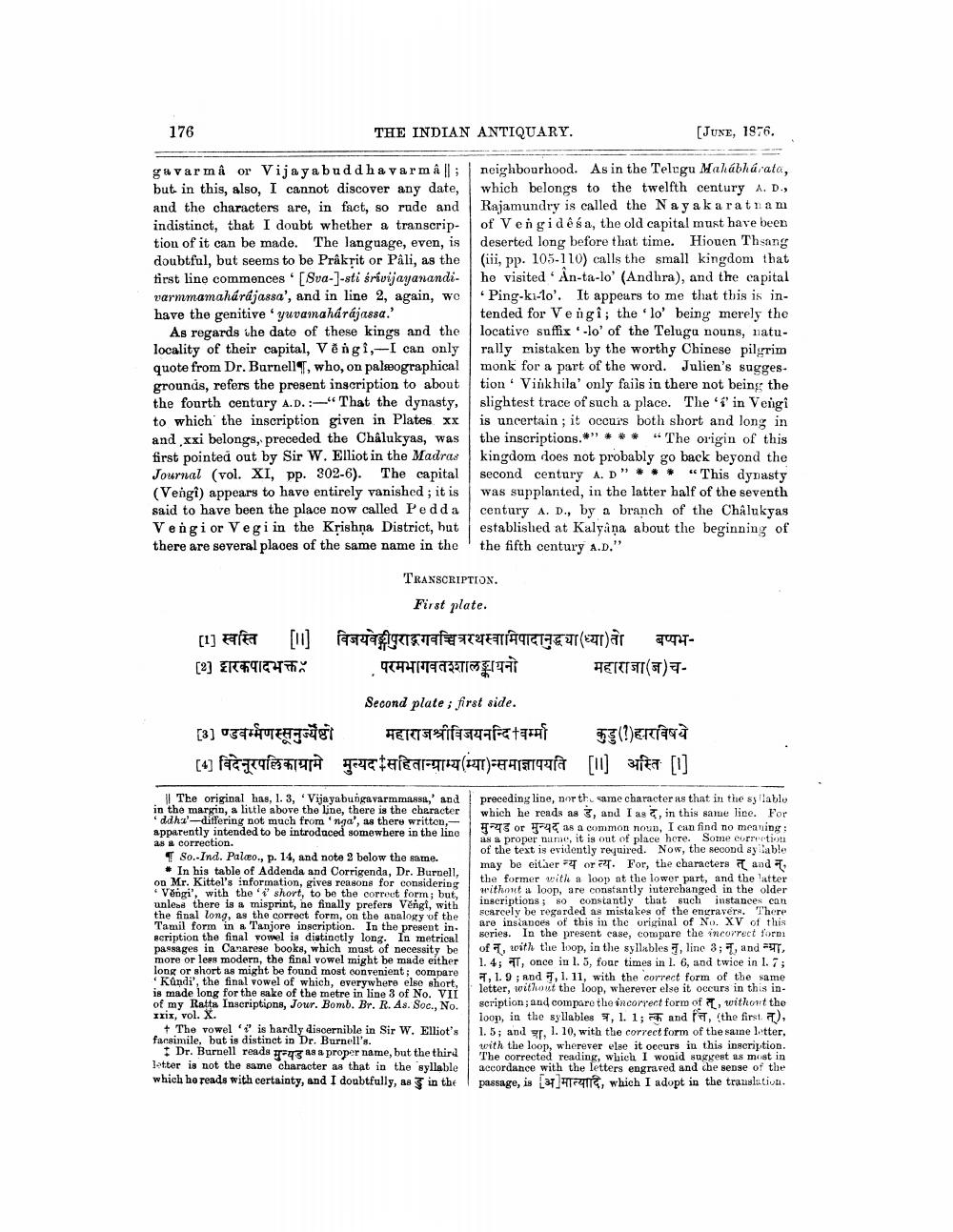________________
176
THE INDIAN ANTIQUARY.
gavarma or Vijayabuddha varmâ ; but in this, also, I cannot discover any date, and the characters are, in fact, so rude and indistinct, that I doubt whether a transcription of it can be made. The language, even, is doubtful, but seems to be Prâkrit or Pâli, as the first line commences [Sva-]-sti śrivijayanandi varmmamahárájassa', and in line 2, again, we have the genitive yuvamahárájassa.'
As regards the date of these kings and the locality of their capital, Vengi,-I can only quote from Dr. Burnell, who, on palæographical grounds, refers the present inscription to about the fourth century A.D. :-"That the dynasty, to which the inscription given in Plates xx and xxi belongs, preceded the Chalukyas, was first pointed out by Sir W. Elliot in the Madras Journal (vol. XI, pp. 302-6). The capital (Vengi) appears to have entirely vanished; it is said to have been the place now called Pedda Vengi or Vegi in the Krishna District, but there are several places of the same name in the
[1] स्वस्ति [2] द्वारकपादभक्त
TRANSCRIPTION. First plate.
[11] विजयवेङ्गीपुराद्भगवच्चित्ररथस्वामिपादानुद्ध्या ( ध्या) तो परमभागवता पो
Second plate; first side. महाराजश्रीविजयनन्दिवम्म
[3]ण्डनम्ननुष्ठा
[4] विदेनूरपल्लिकाग्रामे मुल्यद सहितान्ग्राम्य (म्या) न्
The original has, 1. 3, Vijayabungavarmmassa,' and in the margin, a little above the line, there is the character 'ddha'-differing not much from 'nga', as there written,apparently intended to be introduced somewhere in the line as a correction.
So.-Ind. Palæo., p. 14, and note 2 below the same.
In his table of Addenda and Corrigenda, Dr. Burnell, on Mr. Kittel's information, gives reasons for considering Věngi', with the short, to be the correct form; but, unless there is a misprint, he finally prefers Vengl, with the final long, as the correct form, on the analogy of the Tamil form in a Tanjore inscription. In the present in scription the final vowel is distinctly long. In metrical passages in Canarese books, which must of necessity be more or less modern, the final vowel might be made either long or short as might be found most convenient; compare 'Kündi', the final vowel of which, everywhere else short, is made long for the sake of the metre in line 3 of No. VII of my Ratta Inscriptions, Jour. Bomb. Br. R. As. Soc., No. xxix, vol. X.
neighbourhood. As in the Telugu Mahabharata, which belongs to the twelfth century A. D., Rajamundry is called the Nayakaratnam of Vengidêsa, the old capital must have been deserted long before that time. Hiouen Thsang (iii, pp. 105-110) calls the small kingdom that he visited Ân-ta-lo' (Andhra), and the capital 'Ping-ki-lo'. It appears to me that this is intended for Vengî; the 'lo' being merely the locative suffix-lo' of the Telugu nouns, naturally mistaken by the worthy Chinese pilgrim monk for a part of the word. Julien's sugges tion Vinkhila' only fails in there not being the slightest trace of such a place. The '' in Vengi is uncertain; it occurs both short and long in the inscriptions.*"***"The origin of this kingdom does not probably go back beyond the second century A. D" ** "This dynasty was supplanted, in the latter half of the seventh century A. D., by a branch of the Chalukyas established at Kalyana about the beginning of the fifth century A.D."
The vowel is hardly discernible in Sir W. Elliot's facsimile, but is distinct in Dr. Burnell's.
Dr. Burnell reads eg as a proper name, but the third letter is not the same character as that in the syllable which ho reads with certainty, and I doubtfully, as in the
बप्पभमहाराजा (च) च
[JUNE, 1976.
कुड्डु (?)हारविषये [II] अस्ति [1]
preceding line, north same character as that in the syllable which he reads as 3, and I as, in this same line. For मुन्यड or मुन्यद as a common noun, I can find no meaning: as a proper name, it is out of place here. Some correction of the text is evidently required. Now, the second syllable may be eitzer न्यू or व्य. For the characters त् and न् the former with a loop at the lower part, and the latter without a loop, are constantly interchanged in the older inscriptions; so constantly that such instances can scarcely be regarded as mistakes of the engravers. There are instances of this in the original of No. XV of this series. In the present case, compare the incorrect form of, with the loop, in the syllables, line 3; 7, and T 1. 4;, once in l. 5, four times in 1. 6, and twice in 1. 7; , 1.9; and 7, 1. 11, with the correct form of the same letter, without the loop, wherever else it occurs in this inscription; and compare the incorrect form of, without the loop, in the syllables 7, 1. 1; and f, (the first ), 1.5; and, l. 10, with the correct form of the same letter, with the loop, wherever else it occurs in this inscription. The corrected reading, which I wonid suggest as most in accordance with the letters engraved and the sense of the passage, is [37], which I adopt in the translation.




